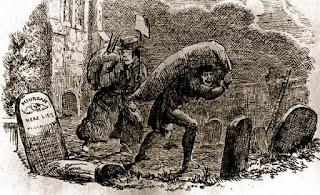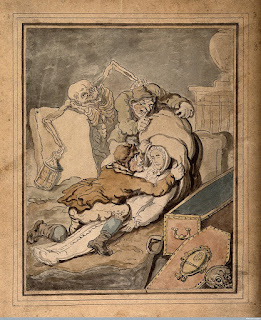---oOo---
All Washed Up….
The last thing that you’d want to happen if you were in the habit of providing anatomy schools with fresh cadavers was to be caught in the act of exhumation. Clever concealment of both your tools and the cadaver when you were leaving the churchyard was key. You did not want to upset the parishioners and ruin your chances of visiting a graveyard again, not when there could be money to be made. Bodies however can sometimes be difficult to hide in a hurry and history has left us with a few macabre stories of the unfortunate events to befall just some of the bodysnatchers that I have found during my research.
Imagine if you will, you've been digging and pulling and folding and stuffing a cadaver out of its coffin into a sack when you hear a noise not too far behind you. Grabbing your quarry you take flight, frantically looking for somewhere to stash your loot until the coast is clear and it's safe to retrieve it. Yes, there were safe houses. Houses where you stashed cadavers and distributed them in a more orderly fashion the following morning, but not all bodysnatchers were fortunate enough to have access to such luxuries.
As a general rule you improvised. Bodies were found stuffed in sacks tucked under hedges, stored under staircases or in unused outbuildings and even on occasion dung heaps. In Peterborough in 1830, the body of a young woman was found in a garden shed, the house being conveniently situated behind the cemetery. Upon further investigation, it was found that a doctor lived at the address. No doubt a handy location! There is also the case of Dr Lowry, ‘a notorious lifter’ who used his house as a site to store cadavers before they were shipped to Edinburgh. Lowry’s house ‘Homefield’ was based in Coldingham in the Scottish Borders, and it is said that a small window acted as means of getting the bodies in and out of the premises. This ‘Resurrection Window’ was just the right size to allow bodies to be passed through and subsequently stored away in a vault found under the floor of the room beyond.
But what about the more gruesome cases?
In 1793, long before the rise of the professional bodysnatcher, while students would still stalk graveyards at night acquiring their own subjects, a strange occurrence happened in a field near Battle Bridge, London. It happened on a Thursday. Limbs of all shapes and sizes were found strewn over the grass. Legs and arms of men, women and children, tossed into the field without a care in the world and for all to see. It is thought that it was the night-soil man’s fault. His round took in the cesspit of a number of ‘dissecting surgeons’ and after diligently going about his duty, he had emptied the contents of his cart in the said field without giving it a second thought.
In 1821, ‘several human bodies with limbs lopped off’ were found mangled under some palisades on the Dover Road. Three females and one child’s body were found intact while a number of ‘hand, feet &c.’ had also been dumped. All were in a high state of decay. It was later concluded that the resurrection men had dumped the bodies and extremities to avoid detection, although they must have gone undetected for a number of weeks judging by the state of decay. No bodysnatcher would risk his freedom for a rotting body.
Several months later Islington was ‘very much alarmed’ when the extremities of both men and women were found floating along the Regent’s Canal. As if this ghastly discovery was not enough, as the limbs were being collected by some local constables, out of the shadows appeared two well-dressed individuals brandishing a knife. Walking calmly over to the various off cuts, one of the men proceeded to hack at one of the limbs, cutting off one of the legs just below the knee. The obvious remonstrations ensued. It is thought that the bodies had been thrown in to the canal by the resurrection men, again hoping to avoid detection.
Floating bodies were not just found in London. Janet Sparks, a onetime parishioner of the parish of Torry, Aberdeenshire, died in 1808 and after being committed to the ground, was hastily removed that same night. Fearing detection, the bodysnatchers had quickly reburied Janet in the sandbanks of the Nigg Bay hoping to collect her body when things had died down. Unfortunately a violent storm blew up and the waves thrashed the sandbank where Janet was stored. Unable to return to get Janet’s body, she was left there to slowly decompose, finally washing up on the river bank opposite the church two months later.
As bodysnatching intensified, stealing a cadaver from a churchyard without being detected became more and more difficult. These are just a few of the methods that Britain’s resurrection men thought of to store cadavers, there are probably many more that we will never know about. Talk about having a skeleton in your cupboard!
Bio:
If you are interested in finding out more about Britain’s bodysnatchers, ‘Digging up the Untold Stories’ is now available to purchase to from Pen and Sword Books, AmazonUk , AmazonUS and all good bookshops.
If you’re on twitter, you can follow Suzie at @Diggingup1800 or via Facebook or Suzie’s blog Britain’s Forgotten Bodysnatchers.



3 comments:
I found a news item in 1808 of a face found at the back of the Isle of Sheppy [sic] eyebrows, eyelashes and hair marvellously preserved and the upper lip seeming never to have been shaved with down upon it but only one ear. Could this be related, or is it, as I first thought, a murder with the face removed to delay identification?
What a fascinating and macabre topic. enjoyed the post. Suzie's book looks intriguing.
Quiet and still seemingly sleeping figures on a stage coach crossing Hounslow Heath at night were found to be hung bodies from Exeter bound for dissection in London!
Post a Comment